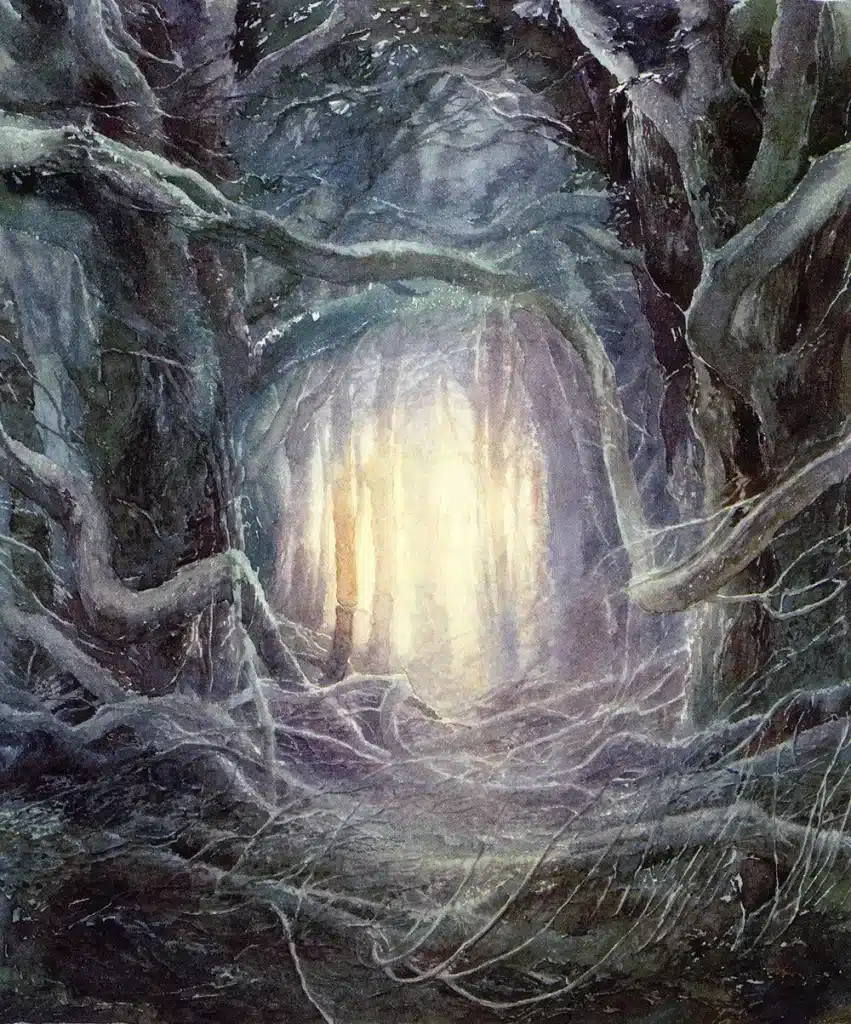Last year, for the month of September, I did a little blog miniseries, focusing on The Hobbit and some of its less-appreciated themes and aspects. And, since I really enjoyed writing those posts, and having a theme to work towards…I decided to do it again this year!
So, over the next few weeks, we’re going to be looking at three stories by Tolkien…stories which, actually, aren’t under-appreciated in the same way that The Hobbit is. But they’re also stories that a lot of Tolkien fans might not pay much attention to, or even know about…and that’s a great shame, because they are among his best writings.
Part of the reason, I suspect, why these particular stories aren’t better loved, is that they have one trait in common with The Hobbit – they do not fit neatly into the Legendarium. Indeed, some would probably argue that they’re not actually part of Tolkien’s Legendarium at all, and so the stories don’t rate a mention in the innumerable YouTube channels, wikis and forums dedicated to Middle-earth. And to be fair, those some are likely entirely correct – arguably, Smith of Wootton Major, Leaf by Niggle, and Farmer Giles of Ham are indeed separate works, disconnected from Tolkien’s history of Elves and Valar and Rings and Hobbits. But I tend to think it’s a little more nuanced than that.
That being said, in the case of at least one of these stories, Tolkien himself deliberately kept all such Middle-earthisms from its pages:
[The Silmarillion] has bubbled up, infiltrated, and probably spoiled everything (that even remotely approached ‘Faery’) which I have tried to write since. It was kept out of Farmer Giles with an effort, but stopped the continuation. Its shadow was deep on the later pans of The Hobbit. It has captured The Lord of the Rings…
J.R.R. Tolkien, Letter 124 to Sir Stanley Unwin
Yet to me, each of the stories still feels distinctly Legendariumish, though it doesn’t matter terribly much. They are, arguably, not necessarily part of Middle-earth’s mythology because each of them are “standalone”; perfectly satisfying tales in their own right, without the weight of Middle-earth’s history to encumber them. To the reader who has miraculously escaped learning anything of Middle-earth, they are perfectly satisfying…and to the historian trying to write a complete account of the happenings in Arda, they are extraneous.
Yet the blood of Smaug runs in the cunning Chrysophylax Dives, if diluted and weakened by the Ages that separate them (as, indeed, the blood of Glaurung burns in Smaug). Even in the latter days of Smith, the Elvish mariners still march forth and make war, as they have since ere the Sun rose, while Elvish maidens dance joyfully in secret glades.
And Niggle…well. Not even Manwë knows where the souls of Men go after they die. So I suppose not even Manwë would know if Leaf by Niggle is, indeed, part of his world, or if Niggle’s Parish lies beyond the far doors of Mandos’ Halls. But the First Voice is undoubtedly kin to Mandos, in some manner.
Further, I would call attention to the fact that Tolkien does not say that Farmer Giles is ‘disconnected’ from the Silmarillion – simply that the Silmarillion was ‘kept out’. And that, to me, implies that there was a very real danger of it intruding…a danger that could only exist if their sub-created borders in Faerie-lands are indeed terribly unclear.
Or, to put it another way, if the Legendarium is akin to the tales of King Arthur and Camelot in some way, then perhaps these short stories are somewhat like tales of Robin Hood and the Lambton Worm. It is of course not necessary for Robin Hood’s England to be the same England that was once ruled by Arthur, they are wholly independent worlds – but I do not think it hurts to fancy that these two heroes trod the same ground, either.
In any case, it is not especially important whether one ‘counts’ these three stories as belonging to the Legendarium or not, they are extremely worthwhile no matter where in Faery they happen to take place. All of this is, in part, to explain why these three stories aren’t nearly so celebrated as anything from Middle-earth. However, it’s also my terribly overblown justification to explain that, in my mind at least, these are the Legendarium’s “Lesser Tales”, in contrast to “The Great Tales” – the stories that make up the bulk of the First Age’s drama.
Lesser, because they are smaller in scope and tragedy. Lesser, because they belong to later years and a more modern world (if one still tinged by Faerie). Lesser, because they are literally shorter, and their heroes are of less consequence than Beren, Túrin or Eärendil. Lesser, because they are not the Great – but in their own small ways, they are related, in theme and thought if not in matter. There is a conceptual symmetry to them as a trilogy that I’m personally quite fond of (for some reason, other short stories by Tolkien like Roverandom or Mr. Bliss never felt as clearly connected to me as these three do).
And to be clear, I do mean ‘Lesser’ as a description of their scope and feel, not of their quality! I’ve loved each of the stories since I discovered them, and hope to approach and describe some of that love in the coming weeks. I first read Farmer Giles at a relatively young age, and was amused by it. I read Smith in my teens, and was haunted by it. And as I age, Leaf feels ever more relevant and insightful to me.
Each of the stories is thematically rich and dense, and though they aren’t overly well-known in wider circles, they are at least well-studied by various Tolkien scholars. So perhaps it’s a little silly of me to write about them at all, but I also love each of them dearly, and this blog is nothing but an excuse for me to write about stuff I love. And with any luck, I’ll focus on aspects of the three stories that are perhaps less-commented upon – namely, upon their titular heroes.
So, over the next few weeks, we’re going to spend a little bit of time with each of the protagonists of these three stories. Niggle the underachiever, the unremembered artist. Giles the accidental hero, the unlikely and overachieving king. And Smith the traveller, the explorer wandering strange scapes beyond mortal lands.
I’m really looking forward to diving deeper into each of these stories in the coming month, and to elucidating a little more concerning my love for each of them. There is a criticism sometimes levelled at Tolkien, and usually unfairly, that his characters are flat, uninteresting, overly simple. But the unlikely trio that is Niggle, Giles and Smith are all rich and faceted figures, and the narrative arcs each of them experience are really compelling, and very relatable.
So, check back in soon, and in the meantime, (re)read Tolkien’s Three Lesser Tales. They might not be overtly related to Tolkien’s broader mythology, but that does not lessen their value – if anything, it enhances it. And I promise, you will not regret checking any one of them out, they are truly every bit as fine as anything Tolkien ever wrote…and are considerably quicker and easier to read, though every bit as ‘weighty’ as his longer works. So, happy reading, and enjoy the Lesser Tales – they are truly worth it, and I’m excited to be working through them this month!

~~~~~~~~~~~~~
Thanks for reading – feel free to check out anything else you may be interested in on the blog, there’s plenty more to discover! Follow me on Facebook and on Twitter to stay up to date with The Blog of Mazarbul, and if you want to join in the discussion, write a comment below or send an email. Finally, if you really enjoyed the post above, you can support the blog via Paypal, and keep The Blog of Mazarbul running. Thanks for reading, and may your beards never grow thin!
